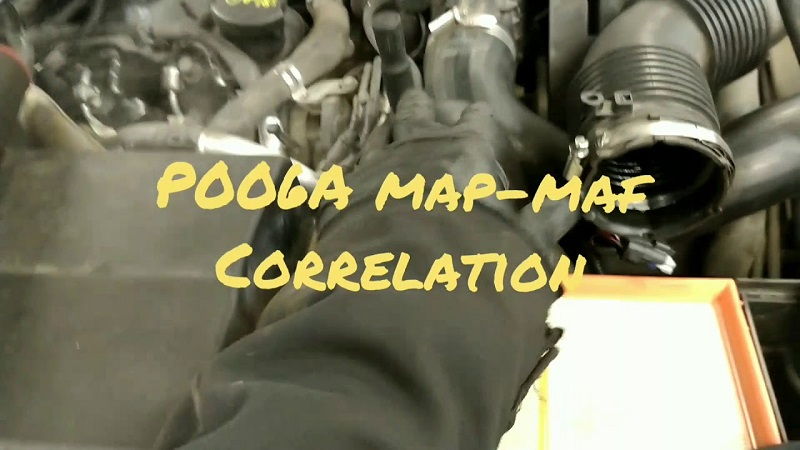This post contains affiliate links. This means I will make a commission at no extra cost to you should you click through and make a purchase [ “As an Amazon Associate, I earn from qualifying purchases.” ]. Read the full disclosure here.
P006A MAP – Mass or Volume Air Flow Correlation Bank 1 GuideMechanic.Com In the intricate network of modern automobiles, the “P006A MAP – Mass or Volume Air Flow Correlation Bank 1” trouble code represents a potential hiccup in the engine’s performance.
For motorists, deciphering these alphanumeric codes may seem like navigating a labyrinth, but understanding their significance can save time, money, and prevent further damage to the vehicle.
The P006A code specifically pertains to the correlation between the manifold absolute pressure (MAP) sensor and the mass or volume airflow (MAF/VAF) sensor within Bank 1 of the engine. To unravel its meaning, let’s break down each component involved.
See Also: P0068 Code: MAP/MAF – Throttle Position Correlation

Firstly, the MAP sensor is a critical component in modern engine management systems. It measures the pressure within the intake manifold, providing crucial data to the engine control unit (ECU) to regulate fuel injection and ignition timing. Essentially, it helps the engine adapt to varying operating conditions, ensuring optimal performance and efficiency.
On the other hand, the MAF/VAF sensor detects the volume or mass of air entering the engine. This information is vital for determining the correct air-fuel mixture ratio, essential for combustion. By accurately measuring airflow, the sensor aids in achieving the right balance between fuel economy, power, and emissions.
Now, the term “Bank 1” refers to the side of the engine where cylinder number one is located. In engines with multiple banks, each bank typically has its sensors and components, including oxygen sensors, fuel injectors, and, in this case, airflow sensors.
When the P006A trouble code appears, it indicates a discrepancy between the readings from the MAP sensor and the MAF/VAF sensor within Bank 1.
This misalignment can lead to several issues, including compromised engine performance, reduced fuel efficiency, and increased emissions.
P006A MAP – Mass or Volume Air Flow Correlation Bank 1
So, what could trigger such a discrepancy? Several factors might contribute to this fault:
Check out this Solary Smoke Machine for Car – DC 12V EVAP Automotive Smoke Tester for Vacuum Leaks

Sensor Malfunction: Both the MAP and MAF/VAF sensors are susceptible to wear and tear over time. Accumulated dirt, oil residue, or electrical faults can impair their functionality, leading to inaccurate readings.
Vacuum Leaks:
Any leaks within the intake system can disrupt airflow measurements, affecting the readings from both sensors. Common culprits include cracked hoses, loose connections, or faulty gaskets.
Faulty Wiring or Connectors:
Electrical issues such as corroded wires, loose connections, or damaged connectors can disrupt the communication between the sensors and the ECU, resulting in erroneous readings.
Intake Manifold Issues:
Damage or leaks in the intake manifold can affect pressure readings, directly impacting the MAP sensor’s accuracy.
Engine Mechanical Problems:
Issues such as valve timing problems, exhaust restrictions, or faulty components within the engine itself can indirectly affect airflow readings, leading to sensor discrepancies.
P006A MAP – Mass or Volume Air Flow Correlation Bank 1

When confronted with the P006A trouble code, prompt action is crucial to diagnose and rectify the underlying issue. Here’s a systematic approach to troubleshooting:
Scan for Additional Codes:
Sometimes, accompanying trouble codes might offer additional clues to the root cause of the problem. Conduct a comprehensive diagnostic scan to identify any related issues.
Inspect Sensors and Wiring:
Begin by visually inspecting the MAP and MAF/VAF sensors, along with their respective wiring and connectors. Look out for signs of damage, corrosion, or disconnection.
Check for Vacuum Leaks:
Perform a thorough inspection of the intake system for any signs of leaks. This includes checking hoses, gaskets, and connections for damage or looseness.
Test Sensor Readings:
Utilize a diagnostic scan tool to monitor the real-time readings from both the MAP and MAF/VAF sensors while the engine is running. Compare these readings to specifications provided by the manufacturer to identify any discrepancies.
Perform Component Tests:
Depending on the findings, conduct specific tests on individual components, such as the MAP sensor, MAF/VAF sensor, or related circuits, to pinpoint the exact source of the problem.
Address Identified Issues:
Once the culprit is identified, take necessary measures to address the underlying issue. This may involve repairing or replacing faulty sensors, repairing vacuum leaks, or addressing other mechanical issues.
Clear Codes and Test Drive:
After addressing the problem, clear the trouble codes from the ECU’s memory and take the vehicle for a test drive. Monitor for any recurring issues and ensure that the problem has been successfully resolved.
In conclusion, the P006A MAP – Mass or Volume Air Flow Correlation Bank 1 trouble code serves as a diagnostic indicator of potential discrepancies between the MAP and MAF/VAF sensors within Bank 1 of the engine.
While deciphering these codes may seem daunting, understanding their implications and following a systematic troubleshooting approach can help resolve underlying issues, ensuring optimal engine performance and reliability.
For motorists, staying informed and proactive when confronted with such codes is key to maintaining the health and longevity of their vehicles.
See Also: P0069 Code: Manifold Absolute Pressure – Barometric Pressure Correlation
- BMW Catalytic Converter Price: What You Need to Know - April 24, 2025
- Scrap Catalytic Converter Price - April 24, 2025
- Honda CR-V Catalytic Converter Price - April 24, 2025
